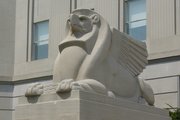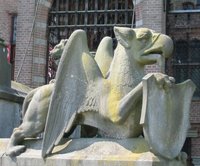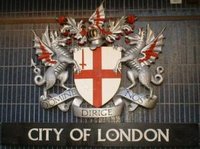Griffin
|
|

- This article is on the animal. For other articles with similar titles, see Griffin (disambiguation).
The griffin (also spelt gryphon, griffon or gryphin) is a legendary creature with the body of a lion and the head of an eagle with the addition of prominent ears. The female has the wings of an eagle. The male (known as a keythong) has projecting spikes instead of wings and is less frequently depicted. The griffin is generally represented with four legs, wings and a beak, with eagle-like talons in place of a lion's forelegs and equine ears jutting from its skull. Some writers describe the tail as a serpent. See the entry European dragon for a 19th century painting of St George and the dragon, showing a dragon very like a classically-conceived griffin.
It was said to build a nest, like an eagle. Instead of eggs, it lays agates. The animal was supposed to watch over gold mines and hidden treasures, and to be the enemy of the horse. The incredibly rare offspring of griffin and horse would be called hippogriff. Griffin was consecrated to the Sun; and ancient painters represented the chariot of the Sun as drawn by griffins. The griffin was a common feature of "animal style" Scythian gold; it was said to inhabit the Scythia steppes that reached from the modern Ukraine to central Asia; there gold and precious stones were abundant; and when strangers approached to gather the stones, the creatures would leap on them and tear them to pieces. The Scythians used giant petrified bones found in this area as proof of the existence of griffins and to keep outsiders away from the gold and precious stones. It has recently been suggested that these "griffin bones" were actually dinosaur fossils, which are common in this part of the world.
Adrienne Mayor, a classical folklorist, has made tentative connections, in Fossil Hunters: Paleontology in Greek and Roman Times, between the rich fossil beds around the Mediterranean and across the steppes to the Gobi Desert and the myths of griffins, centaurs and archaic giants originating in the classical world. Mayor draws upon striking similarities that exist between the Protoceratops skulls of the steppes leading to the Gobi Desert, and the legends of the gold-hoarding griffin told by nomadic Scythians of the region; among the artistic evidence, the 6th century Greek vase on the book's cover is incontrovertible.

Gryphon.gif
Some large species of Old World vultures are called gryphons, including the griffon vulture (Gyps fulvus), as are some breeds of dog (griffons).
Heraldic griffins
Griffin3.jpg
A heraldic griffin (or gryphon) has the hind parts (including legs and tail) of a lion, the upper parts (including feathered neck, wings, claws, and head with beak) of an eagle and also ears. It is the ears which distinguish the griffin's head from an eagle's head in heraldry, which is important because, as well as the full griffin, the griffin's head is also often found in heraldry and would otherwise be identical to the head of the eagle.
Shield_sticker_(colours_brightened).jpg
Heraldic griffins are usually shown rearing up, facing left, and standing on one hind leg with the other leg and the claws raised: this posture is described in the Norman-French language of heraldry as "segreant", a word uniquely applied to griffins, and which is the exact equivalent of the description of lions and other creatures in heraldry as "rampant".
A heraldic griffin was included as one of the ten Queen's Beasts sculpted for the coronation of Queen Elizabeth II in 1953 (following the model of the King’s Beasts at Hampton Court) and this is now on display at Kew Gardens.
The City of London adopted what are usually described as griffins as supporters for its coat of arms, and it marks its boundaries with statues of a single "griffin" carrying the City coat of arms at each road leading into the City of London. However, the City of London griffins are, in fact, heraldic dragons, with scaly bodies and wings, no feathers, and no eagle's beak.
External links
- The Gryphon Pages (http://www.gryphonpages.com) - An online repository of all things pertaining to Gryphons.
- Griffins in Art and on the Web (http://www.isidore-of-seville.com/griffins/), an "art history through griffins"
- Greek Mythology Link Bestiary: (http://homepage.mac.com/cparada/GML/BESTIARY.html) Griffin, quoting Herodotus, Pausanias, Strabo
- Fossil Hunters: Paleontology in Greek and Roman Times (http://pup.princeton.edu/titles/6811.html)
da:Grif de:Greif es:Grifo fr:Griffon (mythologie) fa:شيردال he:גריפון la:Gryps nl:Griffioen ja:グリフォン pl:Gryf (mitologia) ru:Грифон sv:Grip th:กริฟฟิน


